Ap biology unit 3 - Study guides, Class notes & Summaries
Looking for the best study guides, study notes and summaries about Ap biology unit 3? On this page you'll find 111 study documents about Ap biology unit 3.
Page 3 out of 111 results
Sort by
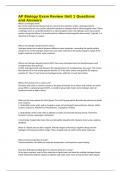
-
AP Biology Exam Review Unit 1 Questions and Answers
- Exam (elaborations) • 8 pages • 2024
-
- $10.39
- + learn more
AP Biology Exam Review Unit 1 Questions and Answers What is a hydrogen bond? One of the weak chemical bonds that are central to the chemistry of life; a hydrogen bond is characterized by the non-covalent attraction between a hydrogen and an electronegative atom. When a hydrogen atom is covalently bonded to an electronegative atom, the hydrogen atom has a partial positive charge that allows it to be attracted to a different electronegative atom nearby. Typically, it is attracted to nitrogen or ...
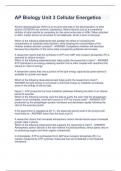
-
AP Biology Unit 3 Cellular Energetics 100% CORRECT ANSWERS
- Exam (elaborations) • 4 pages • 2023
- Available in package deal
-
- $9.99
- + learn more
Alcohol dehydrogenase (ADH) is an enzyme that aids in the decomposition of ethyl alcohol (C2H5OH) into nontoxic substances. Methyl alcohol acts as a competitive inhibitor of ethyl alcohol by competing for the same active site on ADH. When attached to ADH, methyl alcohol is converted to formaldehyde, which is toxic in the body. Which of the following statements best predicts the effect of increasing the concentration of substrate (ethyl alcohol), while keeping the concentration of the ...
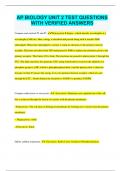
-
AP BIOLOGY UNIT 2 TEST QUESTIONS WITH VERIFIED ANSWERS
- Exam (elaborations) • 18 pages • 2024
- Available in package deal
-
- $9.99
- + learn more
AP BIOLOGY UNIT 2 TEST QUESTIONS WITH VERIFIED ANSWERS Compare and contrast P2 and P1. Photosystem II begins , which absorbs wavelengths at a wavelength of 680 nm. Here, energy is absorbed and passed along until it reaches P680 chlorophyll. When this chlorophyll is excited, it sends its electrons to the primary electron acceptor. Electrons are taken from H2O and passed to P680 to replace the electrons given to the primary acceptor. This forces O2 to form. The electrons are passed to ph...
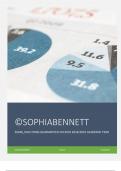
-
AP Biology Unit 1, AP Biology Unit 2 Study Guide with Complete Solutions
- Exam (elaborations) • 23 pages • 2024
- Available in package deal
-
- $10.49
- + learn more
AP Biology Unit 1, AP Biology Unit 2 Study Guide with Complete Solutions Matter - Answer️️ -Anything that takes up space and has mass. Element - Answer️️ -Substance that cannot be broken down to other substances through chemical reactions. Each has a symbol. 92 occurring in nature. Compound - Answer️️ -Substance consisting of two or more different elements combined in a fixed ratio. *Characteristics different than those of its elements CHON - Answer️️ -4 elements essentia...
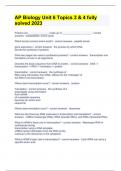
-
AP Biology Unit 6 Topics 3 questions and answers already solved 2023
- Exam (elaborations) • 6 pages • 2023
- Available in package deal
-
- $12.99
- + learn more
AP Biology Unit 6 Topics 3 questions and answers already solved 2023
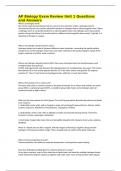
-
AP Biology Exam Review Unit 1 Questions and Answers
- Exam (elaborations) • 8 pages • 2024
- Available in package deal
-
- $10.39
- + learn more
AP Biology Exam Review Unit 1 Questions and Answers What is a hydrogen bond? One of the weak chemical bonds that are central to the chemistry of life; a hydrogen bond is characterized by the non-covalent attraction between a hydrogen and an electronegative atom. When a hydrogen atom is covalently bonded to an electronegative atom, the hydrogen atom has a partial positive charge that allows it to be attracted to a different electronegative atom nearby. Typically, it is attracted to nitrogen or ...

-
AP Biology Exam Review Unit 1 Questions and Answers
- Exam (elaborations) • 8 pages • 2024
-
- $10.39
- + learn more
AP Biology Exam Review Unit 1 Questions and Answers What is a hydrogen bond? One of the weak chemical bonds that are central to the chemistry of life; a hydrogen bond is characterized by the non-covalent attraction between a hydrogen and an electronegative atom. When a hydrogen atom is covalently bonded to an electronegative atom, the hydrogen atom has a partial positive charge that allows it to be attracted to a different electronegative atom nearby. Typically, it is attracted to nitrogen or ...
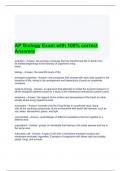
-
AP Biology Exam Bundle (Graded A)
- Package deal • 50 items • 2024
-
- $50.49
- + learn more
1 Exam (elaborations) ULTIMATE AP Biology Exam Review Questions and Answers 2 Exam (elaborations) Pre-AP Biology Final Exam with complete solutions 3 Exam (elaborations) Chapters 1-12 AP Biology Exam Questions and Answers (Graded A) 4 Exam (elaborations) AP Biology Unit 2.1 AP Exam review Questions and Answers 5 Exam (elaborations) AP Biology U
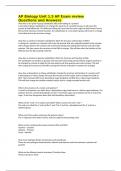
-
AP Biology Unit 1.5 AP Exam review Questions and Answers
- Exam (elaborations) • 2 pages • 2024
-
- $9.09
- + learn more
AP Biology Unit 1.5 AP Exam review Questions and Answers How does a non polar R group substitution affect the folding of a protein? A non polar R group substitution can change the structure of a protein because it will cause the protein to fold differently. This different folding will cause the Non polar region to fold inward. Due to the fact that structure controls function, the substitution of a non polar R group will result in a change in function due to the structure change How does ...
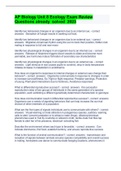
-
PACKAGE DEAL OF AP BIOLOGY QUESTION AND ANSWERS 2023
- Package deal • 28 items • 2023
-
- $40.49
- + learn more
Exam (elaborations) AP Biology Unit 8 Ecology Exam Review Questions already solved 2023 2 Exam (elaborations) ULTIMATE AP Biology Exam Review Question with complete solution 2023 3 Exam (elaborations) AP Biology- Genetics Question already solved 2023 4 Exam (elaborations) AP Biology Unit 6 MCQ Question with complete solution 2023 5 Exam (elabo

$6.50 for your textbook summary multiplied by 100 fellow students... Do the math: that's a lot of money! Don't be a thief of your own wallet and start uploading yours now. Discover all about earning on Stuvia


